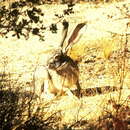More info for the terms:
cacti,
forb,
forbs,
herbaceous,
phreatophyte,
selection,
shrubsThe black-tailed jackrabbit diet is composed of shrubs, small trees,
grasses, and forbs. Throughout the course of a year, black-tailed
jackrabbit feed on most if not all of the important plant species in a
community [
2]. Growth stage and moisture content of plants may
influence selection more than species [
46]. Shrubs generally comprise
the bulk of fall and winter diets, while grasses and forbs are used in
spring and early summer. This pattern varies with climate: Herbaceous
plants are grazed during greenup periods while the plants are in
prereproductive to early reproductive stages, and shrubs are utilized
more in dry seasons [
2,
29,
59,
82]. Shrubs are browsed throughout the
year, however. Most of a jackrabbit's (Lepus spp.) body water is
replaced by foraging water-rich vegetation [
81,
85]. Jackrabbit require
a plant's water weight to be at least five times its dry weight in
order to meet daily water intake requirements. Therefore, black-tailed
jackrabbit switch to phreatophyte shrubs when herbaceous vegetation
cures [
38,
85].
Plant species used by black-tailed jackrabbit are well documented for
desert regions. Forage use in other regions is less well known;
however, it is well established that black-tailed jackrabbit browse
Douglas-fir (Psedotsuga menzeisii), ponderosa pine (Pinus ponderosa),
lodgepole pine (P. contorta), and western hemlock (Tsuga heterophylla)
seedlings, and oak (Quercus spp.) seedlings and sprouts [
22,
39,
43].
Great Basin: Big sagebrush is a primary forage species and is used
throughout the year; in southern Idaho it formed 16 to 21 percent of the
black-tailed jackrabbit summer diet. Rabbitbrush (Chrysothamnus spp.),
spiny hopsage (Gray spinosa), and black greasewood are also browsed
[
2,
28]. Four-wing saltbush (Atriplex canescens) is heavily used in
western Nevada [
89]. In Butte County, Idaho, winterfat comprised 41
percent of black-tailed jackrabbits' annual diet. Fourteen percent was
composed of grasses, with most grass consumption in March and April
[
36]. Russian-thistle (Salsola kali) is an important forb diet item.
Needle-and-thread grass (Stipa comata) and Indian ricegrass (Oryzopsis
hymenoides) are preferred grasses [
2]. Other preferred native grasses
include Sandberg bluegrass (Poa secunda) and bluebunch wheatgrass
(Pseudoroegneria spicata) [
56]. Where available, crested wheatgrass
(Agropyron desertorum and A. cristatum) and barley (Horeum vulgare) are
highly preferred. Cheatgrass (Bromus tectorum) use is variable: It
comprised 45 percent of the April diet on two southern Idaho sites [
28],
but black-tailed jackrabbit on an eastern Washington site did not use it
[
11].
Warm Desert: Mesquite (Prosopis spp.) [
29] and creosotebush (Larrea
tridentata) [
57,
81] are principle browse species. Broom snakeweed
(Gutierrezia sarothrae) and Yucca spp. [
49] are also used. In honey
mesquite (P. glandulosa var. glandulosa) communities in New Mexico,
overall black-tailed jackrabbit diet was 47 percent shrubs, 22 percent
grasses, and 31 percent forbs [
18]. Black grama, dropseed (Sporobolus
spp), fluffgrass (Erioneuron pulchellum), and threeawns (Aristida spp.)
are the most commonly grazed grasses [
18,
29,
82]. Leather croton (Croton
pottsii), silverleaf nightshade (Solanum alaeagnifolium), desert
marigold (Baileya multiradiata), wooly paperflower (Psilostrophe
tagetina), and globemallow (Sphaeralcea spp.) are important forbs,
although many forb species are grazed [
82]. Opuntia spp., saguaro
(Carnegiea gigantea), and other cacti are used throughout the year but
are especially important in dry seasons as a source of moisture [
70].

